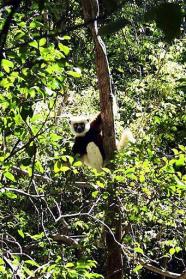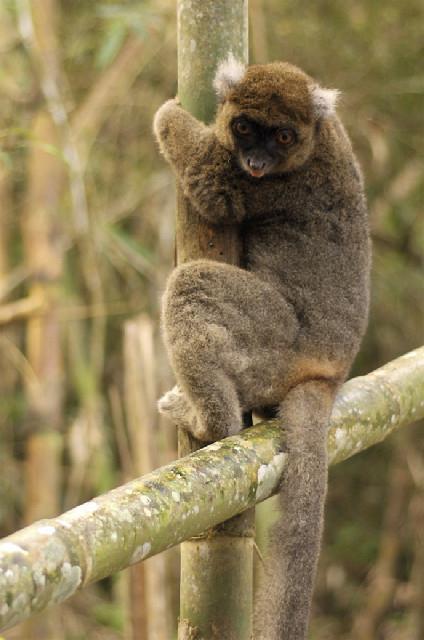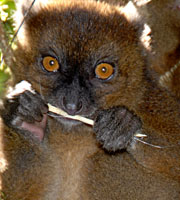October 19, 2009
Rediscovered Extinct Lemur Has Wider Range
The greater bamboo lemur (Prolemur simus) was thought to have been extinct, but was rediscovered in the 1980s in Madagascar.
Now, according to the Aspinall Foundation and the Conservation International, this lemur species has been found at eleven sites in a swathe of forest in the eastern part of the island.

One media outlet apparently feels they can publish any file lemur photo available to go with this story. The above lemur is a Coquerel’s sifaka being pictured with the AFP’s release of information on the new extended range of the greater bamboo lemur earlier this month. Below is an image of the lemur under discussion, from Science Daily.

The discovery of this species’ range extension opens “a new chapter for the species and for the places we can protect it by preserving the forest as the main problem is loss of habitat,” Mahaoly Ravaloharimanitra, a research assistant at the Aspinall Foundation, told the news service AFP.
Primate specialists say that while this type of lemur was once found throughout this Indian Ocean island, today no more than 300 individuals are still in existence. Formerly in the genus Hapalemur, primatologist Colin Groves (who was on the board of directors of the International Cryptozoology Society) placed the greater bamboo lemur in the genus Prolemur in 2001, based on a suite of distinctive dental and chromosomal characteristics.

As its common name implies, the greater bamboo lemur is the largest of Madagascar’s bamboo-eating lemurs. Prolemur simus primarily eats bamboo, which limits its habitat options. Indeed, it feeds almost exclusively on a specific kind, the “giant bamboo,” preferring the shoots but also eating the pith and leaves. It is not known how their metabolism deals with the cyanide found in the shoots; their typical daily dose would be enough to kill humans. Its only confirmed predator is the fossa (Cryptoprocta ferox), but raptors are also suspected. Its range was thought to only be southeastern Madagascar, until these new clusters were discovered.

“They [Prolemur simus] are very secretive, which makes it difficult to approach them and protect them. Most of the time we don’t see the animal, just traces of food or droppings,” Tovanahary Rasolofoharivelo from Conservation International told AFP.
 About Loren Coleman
About Loren Coleman
Loren Coleman is one of the world’s leading cryptozoologists, some say “the” leading living cryptozoologist. Certainly, he is acknowledged as the current living American researcher and writer who has most popularized cryptozoology in the late 20th and early 21st centuries.
Starting his fieldwork and investigations in 1960, after traveling and trekking extensively in pursuit of cryptozoological mysteries, Coleman began writing to share his experiences in 1969. An honorary member of Ivan T. Sanderson’s Society for the Investigation of the Unexplained in the 1970s, Coleman has been bestowed with similar honorary memberships of the North Idaho College Cryptozoology Club in 1983, and in subsequent years, that of the British Columbia Scientific Cryptozoology Club, CryptoSafari International, and other international organizations. He was also a Life Member and Benefactor of the International Society of Cryptozoology (now-defunct).
Loren Coleman’s daily blog, as a member of the Cryptomundo Team, served as an ongoing avenue of communication for the ever-growing body of cryptozoo news from 2005 through 2013. He returned as an infrequent contributor beginning Halloween week of 2015.
Coleman is the founder in 2003, and current director of the International Cryptozoology Museum in Portland, Maine.
Email • Facebook • Twitter •
Filed under Breaking News, CryptoZoo News, Extinct, Media Appearances, New Species




